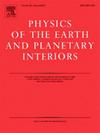地核-气候耦合:由气候过程驱动的地核动力学变化
IF 1.9
3区 地球科学
Q2 GEOCHEMISTRY & GEOPHYSICS
引用次数: 0
摘要
地球整体参数的变化——尤其是白天长度的变化,ΔLOD-are是由包括地核动力学在内的众多地球物理过程引起的。最近在ΔLOD的空间大地测量记录中出现了新的信号,这些信号不能仅仅根据地核的动力学来解释。另一方面,最近的研究强调气候过程对ΔLOD的影响越来越大,但即使这些研究也未能解释上述新出现的信号。在这里,我们提出,一旦我们考虑到“核心-气候耦合”(3C),这些信号就可以得到解释。为此,我们开发了一种新的基于深度学习的算法,称为可解释贝叶斯物理信息量子深度学习(PIQDLIB),该算法考虑了核心和气候动力学之间的所有可能联系。利用PIQDLIB并利用ΔLOD、全球气候变化和核心流模型的观测结果,我们揭示了耦合强度为4±2%的3C。这种动态联系阐明了气候与核心过程之间的非线性相互作用。为了解释这种耦合的起源,我们提出了一种机制,该机制占耦合强度的79±18%,该机制基于由气候过程引起的地球旋转极的偏差所引起的极潮,即由于极地冰盖和全球冰川融化以及陆地储水量的变化而导致大陆-海洋物质再分配的重力过程。这一新发现的3C现象在ΔLOD中表现为准年代际振荡,主周期为12±1年,振幅为0.1±0.02毫秒,但它也包括小幅度的年际和年代际周期,范围为~ 6-9年。这些结果证明了内部和外部地球动力学之间的相互作用,这是更好地理解全球地球物理学的基础。本文章由计算机程序翻译,如有差异,请以英文原文为准。

Core-climate coupling: Changes in the Earth’s core dynamics driven by climatic processes
Changes in the Earth's global parameters—particularly variations in the length of day, LOD—are caused by a multitude of geophysical processes, including that of core dynamics. New signals have emerged in the recent space-geodetic record of LOD that are not explained solely based upon dynamics of the Earth's core. On the other hand, recent studies emphasize the increasing impact of climatic processes on LOD, yet even these fail to account for the mentioned emerging signals. Here we propose that these signals are explained once we account for ‘core-climate coupling’ (3C). For this purpose, we develop a new deep learning-based algorithm termed interpretable Bayesian physics-informed quantum deep learning (PIQDLIB) that takes into account all the possible connections between core and climate dynamics. Employing PIQDLIB and using the observations of LOD, global climate change, and core flow models, we unravel a 3C with a coupling strength of 42 %. This dynamic link elucidates nonlinear interactions between the climate and core processes. To explain the origin of this coupling, we propose a mechanism that accounts for 7918 % of the coupling strength and is based upon the pole tide caused by the deviations of the Earth's rotational pole induced by climatic processes, namely, barystatic processes that result in continental-ocean mass redistribution as a result of polar ice sheet and global glaciers melting and shifts in terrestrial water storage. This newly discovered 3C phenomenon is manifested in LOD as a quasi-decadal oscillation with a main period of 121 year and amplitude of 0.10.02 milliseconds, though it also encompasses small-amplitude interannual and intradecadal periods in the range of 6–9 years. These results demonstrate the interplay between internal and external geodynamics, which is fundamental for a better understanding of global geophysics.
求助全文
通过发布文献求助,成功后即可免费获取论文全文。
去求助
来源期刊

Physics of the Earth and Planetary Interiors
地学天文-地球化学与地球物理
CiteScore
5.00
自引率
4.30%
发文量
78
审稿时长
18.5 weeks
期刊介绍:
Launched in 1968 to fill the need for an international journal in the field of planetary physics, geodesy and geophysics, Physics of the Earth and Planetary Interiors has now grown to become important reading matter for all geophysicists. It is the only journal to be entirely devoted to the physical and chemical processes of planetary interiors.
Original research papers, review articles, short communications and book reviews are all published on a regular basis; and from time to time special issues of the journal are devoted to the publication of the proceedings of symposia and congresses which the editors feel will be of particular interest to the reader.
 求助内容:
求助内容: 应助结果提醒方式:
应助结果提醒方式:


